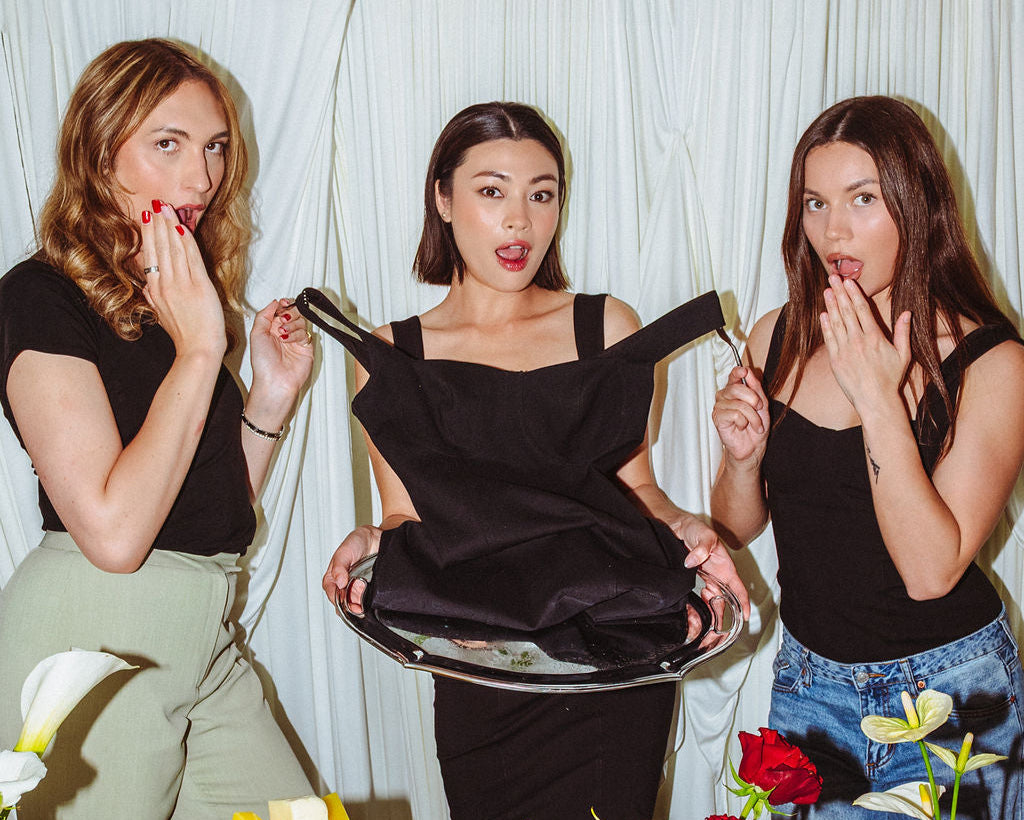Stylist with Medical Degree Believes Clothes Are Emotional Medicine
“Wearing something that doesn’t feel right... it reminds you of what you wish was different. That can be invisible—but deeply felt.”
Q: “So, who is Shelley Kemmerer?”
Shelley Kemmerer wears many hats—physician assistant, business owner, mom, and now, stylist. But for her, fashion was never just about what looked good. It became a way to reclaim comfort and confidence during a time of massive transition.
“There’s the glamour of saying I own my own company,” she told us, “but behind the curtain, there’s stuff going on constantly.”
Between building businesses, raising kids, and navigating postpartum shifts, Shelley found herself rethinking not just her wardrobe, but her relationship with her body—and the stories clothes can hold.
When Style Isn’t Just Surface
Q: “What is a common misconception you hear?”
“That the transition from healthcare to fashion is more about vanity or escapism and it's not.”
For her, it was about depth, not distance.
“In urgent care, you’re in and out. There’s no time to truly connect,” she explained. “I wanted to help people feel better in their own skin, and I’m just doing that through a different medium.”
Styling, for Shelley, isn’t about trends—it’s about emotional well-being. It’s about helping people see themselves again, through the things they choose to wear.
“You’d be surprised what comes up when we go through someone’s wardrobe,” she told us. “Clothes hold memories. They hold grief. They hold growth.” Sometimes, it’s about color analysis. Sometimes, it’s about letting go of clothes that carry old versions of you. But always, it’s about showing up in a way that feels real.”
Her Boob Story: Pain, Perception & Postpartum Identity
Q: “What is your ‘Boob Story’?”
For Shelley, becoming a mother meant her relationship with her body—and especially her breasts—shifted fast.
“When I was pregnant, I went from being barely an A cup to a full C, even a D,” she told us. “And suddenly that became a point of conversation—like, people only wanted to talk about my boobs.”
What started as a physical transformation quickly became emotional. Her body was changing faster than she could process it—new bras, new curves, a new baby—and none of it felt like hers. She was grinding through clinical rotations, studying for boards, and cluster-feeding through the night. The nonstop cycle of studying, pumping, feeding, and exams made it nearly impossible to come up for air.
After her son was born, her breast size dropped again. Clothes stopped fitting. Confidence cracked. “Nothing fit. Nothing felt like me,” she said. That shift—gaining and then “losing” curves—left her grappling with how others perceived her and how she saw herself.
Q: How did these rapid changes make you feel?
“I think many women have this complicated relationship with their bodies. Wearing something that doesn’t feel right... it reminds you of what you wish was different,” she said. “That discomfort can be invisible but deeply felt.”
But she also sees the power in finding something that does feel right. “A bra that supports you—not just physically, but emotionally—can feel like you’re reclaiming a part of yourself.” That’s why Shelley was drawn to VKTORI.
“What you’ve developed gives people an opportunity to reframe that relationship with their body—and their boobs. And that’s been missing for a long time.”
Clothes Remember What We’re Trying to Forget
Shelley’s work lives at the intersection of psychology and personal style. She points to the science behind enclothed cognition—the idea that clothing impacts not just how we feel, but how we function. Research by Adam and Galinsky found that people who wore lab coats—symbolically associated with focus and professionalism—performed better on attention-based tasks than those in their everyday clothes.
The takeaway? It’s not just about what you're wearing, but what that piece means to you. The psychological impact of clothing is most powerful when it combines both the physical act of wearing it and the symbolism we attach to it.
But it goes deeper than lab coats. Shelley sees clothing as emotional archives.
“You’d be surprised what comes up when people go through their closets,” she said. “A dress they wore before a divorce. A top they kept after losing someone. These pieces hold more than fabric—they hold memory.” Sometimes it’s grief. Sometimes it’s growth. But it’s always there.
For many of her clients, discomfort doesn’t start in the mirror—it starts in the mind.
“There’s this real rejection of what they’re wearing. They’re constantly reaching for the same pieces that feel ‘safe,’ even if they don’t fit right anymore. Even the wrong color can bring up emotions they weren’t expecting.”
Her goal? To help them take up space—physically and emotionally.
“Sometimes we’re dressing to disappear. I want people to feel like they can expand.”
Redefining Success: What She’s Learned as a Business Owner
Success isn’t about checking every box or following someone else’s blueprint—it’s about owning your path. As Shelley Kemmerer puts it, “there used to be some shame in not being able to do it all”—but now? She’s ditched the pressure and redefined success on her own terms. It's not about doing everything perfectly; it's about knowing when to pivot, setting your own milestones, and trusting that even if it’s messy, you’re still moving forward.
“Fail fast, rebound faster,” she says. “Nobody is pulling you over the finish line... you have to pivot and trust the process.”

About Shelley Kemmerer
Shelley Kemmerer is the founder of Ne Plus Ultra Atelier, a style consultancy that’s part science, part soulwork. As a Physician Assistant turned stylist, she’s blending her clinical insight with creative intention to help people reconnect with themselves—through their closets.
Her signature approach includes expert color analysis, personalized wardrobe refinement, and Lovely Lately Events—intimate, at-home gatherings centered on self-expression and community. Whether it’s letting go of the old or making room for something new, every interaction is crafted with care.
Follow along w/ Shelley:

